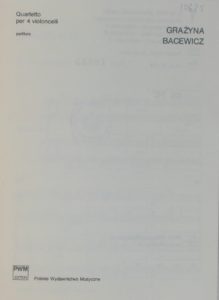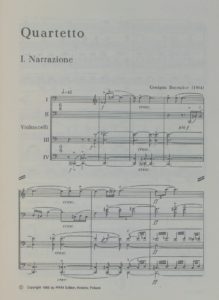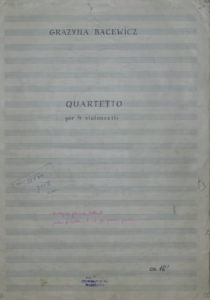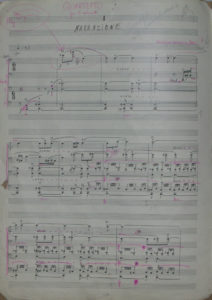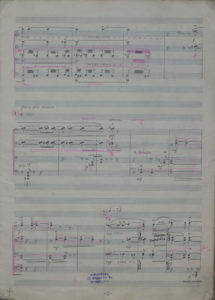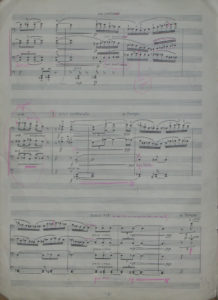- Quartetto per 4 violoncelli, PWM score, title page
- Quartetto per 4 violoncelli, PWM score, Narrazione
- Quartetto per 4 violoncelli, PWM score, Riflessioni
I have long thought about writing a quartet for four cellos. The premises of the piece were to be very different from those of the “Quartet for Four Violins”, which I composed many years ago and which is a pedagogical piece, as it were. Bringing together four cellos attracted me with the richness of its sound matter. When working on the piece, finished in the autumn of 1963, I came to the conclusion that an ensemble of four cellos is an inexhaustible treasure for a contemporary composer. The concept of the piece forced me to largely reject some of the elements of playing, perhaps the most characteristic of the cello, like, for example, broad cantilena. I probably return to this line-up and will treat it completely differently. The “Quartet for Four Cellos” consists of two movements entitled: 1. Narrazione, 2. Riflessioni.
In line with this declaration [Grażyna Bacewicz: note in the programme of the 8th Warsaw Autumn Festival, 1964], the composer weaves the narrative of the pieces out of a number of sound planes constantly fluctuating through textural changes and use of various means of articulation.
However, the first movement, Narrazione, has a clear form of a reprise shaped by a repetition in the final fragment of the first twelve bars followed by a coda with a recapitulation, in the last three bars, of a turn that is a paraphrase of the beginning of the composition. The main idea of the first movement is built as a quasi-imitation: beginning with the fourth cello, successive instruments enter with large interval leaps upwards, holding their notes for a few bars. In the case of cellos four and three we are dealing with a dyad, respectively: augmented octave (C2-C3 sharp) and ninth (D3-E4 flat), in the case of the first cello – only a leap from E flat to E, with the instrument holding the second note. The second cello is from the very beginning much more lively; after leaping from C2 to C3 sharp, it spins a kind of melody, stopping after some time on a repeated G4 sharp. Soon the other instruments begin to create various kinds of more static or lively arabesques. The narrative in this movement is built by dissonant chords sounded over several bars, imitative structures, interwoven passages played in a variety of ways, for example sul ponticello alternating with ordinario or sul tasto, and short tremolos. A change comes with a fragment beginning with a series of chords played come percussione (gettato), initially by the fourth and second cello, and then in a chordal passage by all instruments with a subtle change of the bowing to saltando. A background for these “dry” sounds” is the note C4 held by the first and third cellos, and then a kind of melody played by the first cello. The fragment (from no. 7) can be regarded as the beginning of the middle part of Narrazione, but we find a unique character also in the following section with a rarefied texture woven by individual motifs scattered in space. However, the specificity of this movement lies in the appearance of some moving patches of colour shaped by textural and agogic changes, fading in line with the instruction perdendosi appearing several times.
While the first movement, like its title suggests, is more narrative in nature, with cantilena passages and short imitative fragments, the second movement – Riflessioni – is dominated by variously shaped sound forms of homogenous or internally varied nature over a given section. The picture is complemented by a rich and changing articulation. The very beginning is characteristic, with the first cello taking up, after a pizzicato chord, a toccata-like, rhythmic motif (fourth flageolet on the note C) produced by means of the col legno-saltando technique, in pp. The motif, with its rhythm modified, is then taken over by the second cello. Short, overlapping ostinatos with different rhythms, fleeting glissandos or quasi-glissandos, quick passages played saltando, untypical, occasionally “unpleasant” sounds made by the instrument – like the final fragment of ostinato repeated chords produced by playing col legno – make the Quartet for 4 Cellos an interesting sonic experiment, breaking somewhat the auditory habits associated with the instrument.
The Quartet for 4 Cellos was premiered on 24 September 1964 at the Warsaw Autumn Festival. The performers were Alexander Ciechański, Jerzy Węsławski, Roman Suchecki and Marian Raczak. The same artists made a recording which in 1966 was presented to the BBC Radio 3 listeners.
- Quartetto per 4 violoncelli, manuscript (Warsaw University Library), title page
- Quartetto per 4 violoncelli, manuscript (Warsaw University Library), Narrazione, p. 1
- Quartetto per 4 violoncelli, manuscript (Warsaw University Library), Narrazione, p. 2
- Quartetto per 4 violoncelli, manuscript (Warsaw University Library), Narrazione, p. 3
